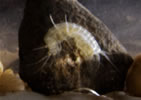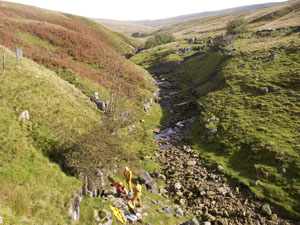As you enter a cave you will pass through a number of 'zones' - the outside, the entrance, the threshold and then into the dark zone. The most obvious change is the change in light intensity - green plants need this to survive and so as it decreases the number of species decreases until none can survive.
Outside the cave the climatic conditions change constantly. The light allows green plants to grow in abundance, these are eaten by herbivores who are in turn eaten by carnivores. When any of these die they may be eaten or decomposed by bacteria and fungi, the nutrients released are used by plants for new growth. All these organisms create a complex and changing food web. In winter, when daylight and temperatures are reduced, green plant growth is reduced or stopped and some creatures hibernate until more food is available.
At the entrance there is often a deep shade cast by the rock face or by overhanging vegetation beyond the reach of grazing sheep. The proximity of the entrance keeps humidity high and reduces the variation in temperature. It may also prevent rain from falling onto the plants. As you pass through the entrance green plants come to an abrupt end except for patches of green algae on the walls and ceiling facing the entrance.
The variation in e.g. altitude, land use, seepage, rock types in proximity to cave entrances, creates a mosaic of conditions for plants. These vary from exposed limestone with base rich mineral surfaces to more acidic conditions where humus has accumulated.
The threshold is the zone between the entrance and the limit of daylight. This zone will be protected from frosts in winter and heat in summer; humidity varies less than outside. Some plants will be able to survive if there is enough light and there is a suitable substrate to grow on. Larger animals (e.g. badgers, foxes), may use this zone in small caves for shelter.
In the threshold of the cave you will find creatures commonly seen outside, such as woodlice, earthworms, beetles and millipedes living on the organic debris on the floor of the cave. Some insects like the cave threshold, each species will be found at a certain time of year and in the same position within the threshold. Spiders will also be found living in the threshold. Like many creatures they avoid competition for limited food by occupying different niches. Some live by the entrance catching insects as they enter and leave the cave, others live further in catching things crawling across the walls.
The dark zone lies beyond the reach of daylight. Any green plants here will be accidentals. There will be spores from algae and bryophytes (mosses, liverworts, ferns), seeds of higher plants, and a few etiolated seedlings. A few creatures use this zone for shelter - bats are the best known example. They may use it for roosting in summer, hibernating in winter or as a nursery to rear their young. Also in the dark zone you will find creatures that possibly did not choose to be in the cave e.g. trout, bullheads, frogs; they can survive if they find enough to eat. Also in this zone are the troglobites that have adapted to life in the dark over numerous generations. The cave troglobites in Britain include representatives of shrimps, springtails, spiders, mites, and isopods; some other creatures are thought to be on the evolution trail to become troglobites.
Humidity is constant and very high, usually between 98 and 100%. Near entrances with draughts it may drop to 75%, this is still much higher than the lowest levels recorded outside the cave. The draughts change direction depending on the outside weather. Air moving into the cave in winter may be at a lower temperature than the air in the cave - it will warm up and be able to hold its water vapour. In summer the air flowing into the cave cools down and becomes saturated with water vapour, it condenses on the walls and ceiling of the cave.
|
Tip of a straw stalactite, Lost Johns Cave |
The temperature deeper in the cave is fairly constant; 6-9C in the caves of the northern England. Surface streams and draughts entering the cave will modify this temperature but this effect decreases the further into the cave you go. The temperature can be colder than this in winter due to the number of caves that contain streams originating on the surface, in winter this water entering the cave may be close to freezing. The water flow on the many vertical pitches also creates powerful draughts such as in the main chamber of Gaping Ghyll and in Diccan Pot. Entrance passages and short caves such as those around Morecambe Bay are influenced by the conditions outside and so will vary more widely than further into the caves.
|
Surface stream entering the 100m shaft of Gaping Ghyll, Ingleborough |
In these zones there are a variety of habitats available for creatures such as mud, sand, rock, still and running water, flood zone, flowstone, soil, moonmilk, shale etc.
There are many active streams in the northern caves and so many caves are prone to flooding. Most streams originate on non-karstic rock such as gritstone and disappear underground on reaching the limestone. These allogenic streams bring in organisms from outside, which may or may not survive in the cave. Some caves such as Meregill Hole on the side of Ingleborough are subject to violent flooding and as a result organisms are a bit thin on the ground beyond the mere at the entrance. Other caves which do not flood violently often have a greater variety of life due to the more stable conditions e.g. those along Attermire Scar.
|
Easegill river bed in dry conditions. There are many cave entrances along the banks of the stream, many of which flood quickly during wet weather. |
|


.jpg)

